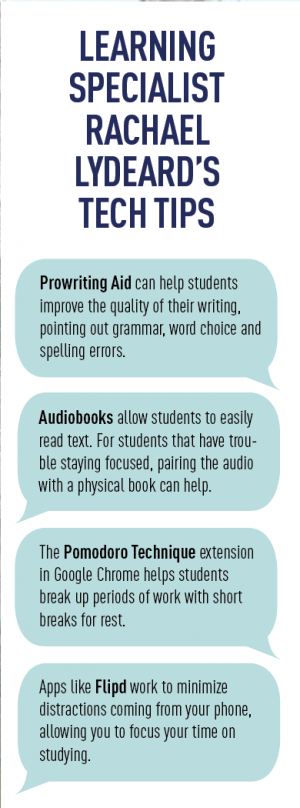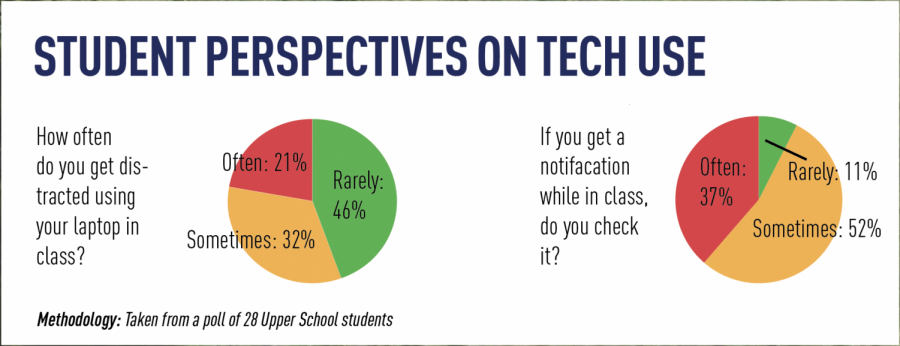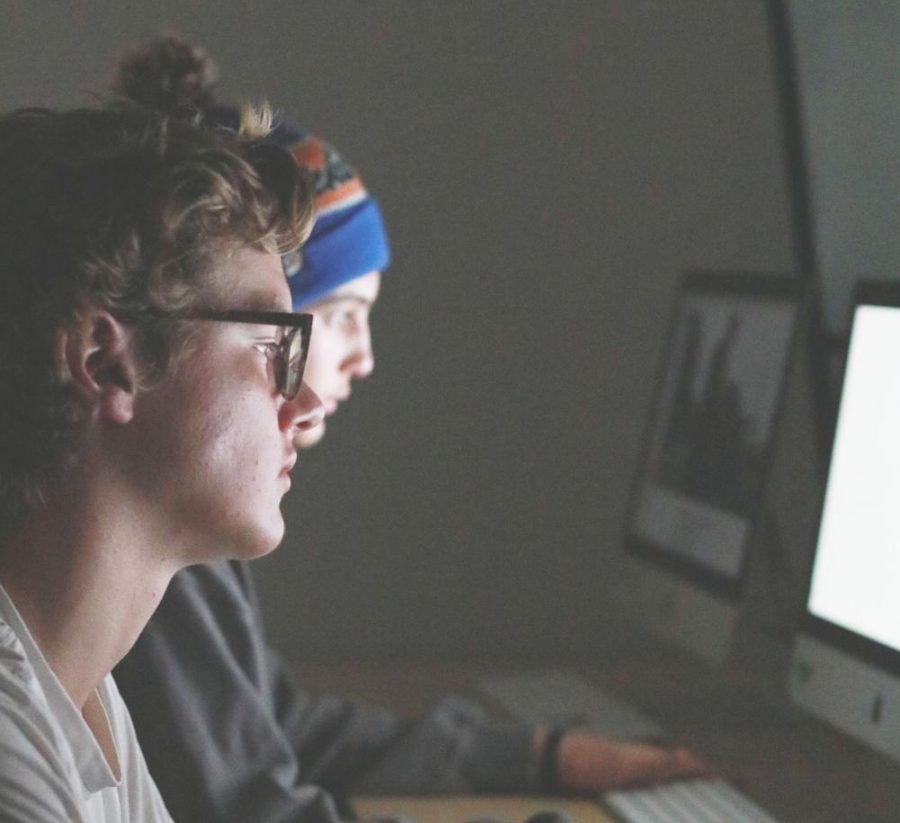Tethered to Tech
UPrep’s laptop policy has changed how students learn
Photo: Aidan Lee
“We wanted to depict both a reliance on technology and how it draws students away from the classroom.” – Aidan Lee
University Prep students spend hours of their school day staring at bright laptop screens as they type notes on Word documents and sift through articles on library databases. Technology offers students novel opportunities for collaboration and access to global perspectives, but such benefits do not come without a cost.
Since autumn 2013, UPrep has required Upper School students to buy laptop computers as part of their school supplies with the hope that they will facilitate learning and prepare students for life beyond high school in a world increasingly dominated by technology. Science teacher Brent Slattengren was a member of the original committee that helped introduce the device program to UPrep classrooms.
“The thinking was that we needed the students to be more independent and not reliant on computer labs,” Slattengren said. “The way society is going, it is becoming more and more important to have your own devices.”
When the laptop program launched in 2013, UPrep hired Director of Learning Design and Technology Jeff Tillinghast to help support teachers integrating tech into their classrooms. He thinks that laptops can help teach students to learn how to process information in a digital world.
 “As a school, our goals are that people are going to be able to organize information effectively because the information that you use in the world is primarily digital,” Tillinghast said.
“As a school, our goals are that people are going to be able to organize information effectively because the information that you use in the world is primarily digital,” Tillinghast said.
For senior Nikki Falicov, technology makes it easier to take and organize notes in class.
“It’s changed how I synthesize information. It’s become easier to write down large amounts of material and then focus on finding the main idea of a lecture because of the speed with which I can take notes or record a lecture and replay it later,” Falicov said.
History teacher Patrick Grant has been working at UPrep since 1985. When he first began teaching at UPrep, classroom technology consisted of slide projectors and VHS tapes. He finds that, for the most part, increased technology has helped make his classrooms more efficient and allows for easier communication outside of school hours.
“It allows for the ability to check in on progress and work without having to wait for going to a class,” Grant said. “I use the grade book in Schoology and so I can provide feedback right away.”
Falicov agrees that technology facilitates collaboration and helps keep students connected outside of the classroom, especially on snow days.
“Google Docs has become a massive part of my school experience and has helped my grade and learning improve, as well as collaboration skills,” Falicov said. “I enjoy using technology, because it allowed me to have classes over the snow days and not be behind on material for exams.”
English teacher Chirstina Serkowski appreciates that technology has allowed students access to increased information.
“We’re connected to vast amounts of information and other people and other perspectives,” Serkowski said. “You all have traveled around the globe already, whether you’ve physically traveled around the globe or not. So I think there’s access to broader perspectives, more perspectives, if you choose to access them.”
Despite the access it may provide, technology use in classrooms is paired with some obstacles. Dr. Donald Shifrin, a retired pediatrician and fellow of the American Academy of Pediatrics, devoted decades of his life to studying how media impacts children. He acknowledges that increased access to information also means increased access to distractions.
“You have the library right in front of you. The difficulty is that, because everything comes instantaneously, we tend to be extremely distracted,” Shifrin said. “There’s a lot of noise out there on the great internet that’s vying for our attention.”
Director of Integrated Learning Shannon Salverda is concerned that distraction due to technology is negatively impacting student learning.
“I see kids missing big chunks of their lesson because they’re doing something independent on their device, and that’s a concern,” she said. “I’m a big fan of technology, but I think learning how to use it appropriately is a key.”
Shifrin warns that students may see distracted working as multitasking, and therefore, not problematic.
“We really aren’t multitasking, we’re just switching rapidly,” Shifrin said. “Our brain has a physiologic cost of doing that. It gets exhausted faster, and you’re going to make more mistakes.”

Assistant Head of School for Academics and Strategic Initiatives Richard Kassissieh agrees that technology use can be distracting, but sees it as necessary to prepare students for their futures.
“This is the world we live in now and the school made a commitment to preparing students for the future,” Kassiessieh said.
Shifrin agrees that students should have access to technology, but believes that they also need to have boundaries around technology use.
“The single most dangerous thing I think we can do to … teenagers is to deny them access to this disrupting influence called the internet,” Shifrin said. “But the second most dangerous concept is to give them unlimited access to technology.”
Education, Shifrin believes, is key to helping children and teenagers understand how to use technology productively and healthily.
“I want kids to use this tool to their advantage and not to their disadvantage. In order to do that, they have to understand that the tool is there for a purpose, but it has its negatives as well,” Shifrin said.
Although she appreciates the accessibility technology provides, senior Sasha Lees agrees that students need to learn how to most effectively use devices in school.
“I think we’ve kind of been given this technology and guidance on how to use it, but it’d be really helpful to have people try to assist you in learning how to use technology to better benefit your learning,” Lees said.
As students approach a tech-saturated world, Tillinghast thinks it’s important that UPrep continues to help students address societal questions about the role of technology in our lives and the world around us.
“Those are questions that we don’t have the luxury of ignoring, and pretending they don’t exist,” Tillinghast said. “It’s our responsibility as a school to engage with them and try to figure it out. And to, hopefully, come through that process and coach everyone in the community to be more effective digital citizens to be a more effective citizen in the world.”
Your donation will support the student journalists of UPrep.



